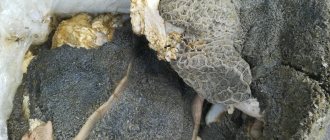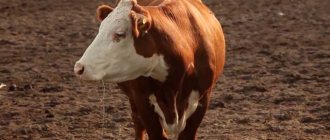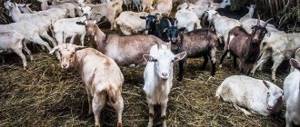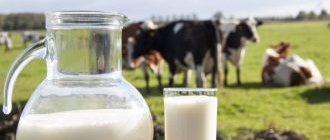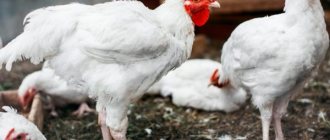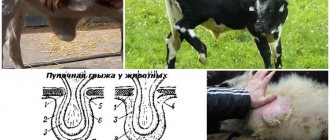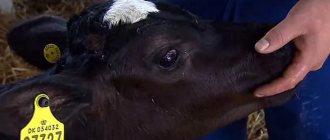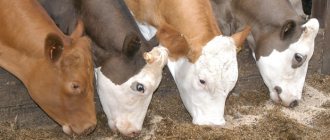Should calves be given antibiotics if they have diarrhea?
Regarding the use of antibiotics, there is no consensus even among veterinarians.
Almost everyone will agree that antibiotics will help calves with diarrhea and some other signs of systemic bacterial infection: fever, bloody diarrhea, swollen joints or belly buttons, and so on. However, many experts say antibiotics are not necessary in mild cases. In their opinion, it is enough to monitor hydration, and everything should be fine. Still, there is an opinion that the use of antibiotics may be indicated, even in the simplest, uncomplicated cases, since calves with diarrhea have a higher number of gram-negative bacteria in the small intestine. Over time, even if the diarrhea passes, the pathogens will still remain and will manifest themselves at the first opportunity. In addition, some dangerous bacteria circulate in the blood - according to statistics, they are found in 40% of sick animals. As practice shows, calves treated with antibiotics have lower mortality rates and higher growth rates. Antibiotics should be used orally or by injection. Use “systemic” antibiotics; that is, those that are absorbed from the gastrointestinal tract. They are necessary to prevent pneumonia. Drugs that reduce intestinal motility and corticosteroids should not be used. If antibiotics are ineffective after two to three days of use, discontinue use. During salmonellosis outbreaks, antibiotics can cause the release of excess endotoxins, so try using infusion (drip) therapy only.
In modern veterinary medicine, it is common practice to prescribe flunixin meglumine for ordinary diarrhea or bloody diarrhea. It is an anti-inflammatory drug that can speed up the recovery of even very sick animals. Studies have shown that one to two doses of flunixin within 24 hours significantly reduces livestock mortality. Activated carbon is an excellent adsorbent. 1 tablet per 10 kg of live weight. You will also need vitamin AD3E (at a veterinary pharmacy) 10 ml once a day.
Pharmacy antibiotics often use tetracycline (3 tablets 2-3 times a day) or chloramphenicol. You can also try phthalazole. But an overdose threatens dysbacteriosis. Treatment can be supplemented with human bifidumbacterin.
As for injections for diarrhea, you can use Telosin or Baytril according to the scheme from the instructions included with the drugs.
If you are diagnosed with a digestive disorder...
The reasons why a young animal is sick can be non-infectious and infectious.
Non-infectious conditions include dyspepsia.
It may be caused by the following factors:
- feeding the calf cold colostrum;
- drinking colostrum from a sick cow (mastitis);
- overfeeding;
- eating sour colostrum;
- late start of feeding, insufficient enrichment of colostrum with nutrients due to poor nutrition of the cow during pregnancy, which leads to a decrease in its immunity.
Dyspepsia can begin due to dirt in the room or improper maintenance of babies. Any climatic deviations, be it overheating or hypothermia, poor ventilation in the room, stuffiness, non-compliance with sanitary standards, dirt, violation of the feeding regime - they will very quickly affect the condition of the calves. Deficiency of vitamins such as tocopherol and retinol, as well as important microelements, leads to dyspepsia and subsequent diarrhea.
The main symptoms that are observed with dyspepsia:
- apathy and lethargy of the animal;
- poor appetite;
- lack of interest when the owner appears;
- sides and tail stained with feces;
- feces smell sour or rotten;
- The baby has rapid, shallow breathing.
In case of indigestion, the temperature usually does not increase, remaining at 37.5-39.5 degrees, while in the case of a toxic form of dyspepsia and the presence of poisoning, it is 40-41 degrees. In general, liquid bowel movements can occur up to 14 times a day, which, of course, is exhausting for the animal. His nose becomes rough and dry, his fur becomes dull, his eyes gradually become sunken, and this indicates imminent death.
It is clear that with such a clinical picture, simply providing normal nutrition and microclimate will not help the calf - in such a situation it is important to start treatment as soon as possible:
- The first thing to do is put the animal on a starvation diet for 24 hours. They give only boiled water with the addition of salt and glucose (50 g per 1 liter), the water should be warm (38-40 degrees). You can add onion peels to boiling water (200 g per 1 liter).
- Starting from the second day, the animal is transferred from water to an enveloping oatmeal decoction, but first they are given gastric juice diluted in water in a ratio of 1:4. To prepare it, take one part of selected oats to 10 parts of water, cook for at least 5 hours over low heat and drink in large quantities. Flax or rice is used in the same way. They also make a mixture of warm brewed black tea, three egg whites and salt (1 tablespoon). Use 10 g per kg of animal weight.
- On the third day, if the calf is not diarrhea, you can add a little milk to the decoction. After another day, 500 ml of milk is given, diluting it in a decoction. The amount of milk is gradually increased to normal, but only if the animal is feeling normal.
It should be borne in mind that if diarrhea continues after two days of such treatment, antibacterial drugs will be needed; No-shpa is used for intestinal spasms. Boiled water can be replaced by decoctions of the following plants - oak bark, elecampane, horse sorrel, alder catkins, St. John's wort.
Treatment at home
The sick animal is kept warm and dry, with good air circulation. The premises and equipment are regularly cleaned and disinfected. Overfeeding a sick calf is prohibited. Milk, feed and salt are excluded from the diet until the digestive tract is restored. The pet is treated in accordance with the diagnosis.
Medication
Medicines are used for severe diarrhea caused by infection or intoxication. You can give medications only after consultation with a veterinarian, so as not to harm the animal’s body.
Rehydrates
These are oral medications used to restore water-salt balance in the body. The most popular remedy is called “Rehydrate”. The medicine should be made as follows: dissolve 3 packages in 10 liters of water heated to 70 °C and stir. Treatment lasts a week. In the first 2 days, the calf is fed 6 times, the solution is added to 250 ml of cow's milk or a substitute when feeding milk replacer. You can store the medicine for 3 days in a cool place.
Sorbents
These are body cleansers of toxins. The calf can be treated with Bifidumbacterin intended for humans, which quickly restores the intestinal microflora. The powder is dissolved in warm water - 1 serving per teaspoon of water. The daily norm is 12-15 servings, divided into 2 or 3 doses 30 minutes before feeding. Treatment lasts 1.5 weeks.
Enzymes
Should be given if the calf's diarrhea is due to enzyme deficiency. An effective remedy is Gastrovet powder: 10 g dissolved in 10 liters of water heated to 50 °C. To stop diarrhea, add the solution to cow's milk, leave it for some time to ferment, and give it to the calf to drink. The daily dose, 90-110 ml, is divided into 3 doses.
Probiotics
These are restorers of intestinal microflora. Pharmacy “Bifidumbacterin”, veterinary “Lactobifadol” and “Olin” are suitable. The dosage of “Lactobifadol” is 0.2 g per 1 kg of body weight, the medicine is dissolved in water at 30 °C, given 2 times a day with food, treatment is continued for at least a week. Probiotics are diluted just before use, since the lifespan of beneficial bacteria in the external environment is short. Monosporin is used to treat dairy calves under one month old. It is added to food in 50 g doses.
See also
What to do and how to feed a calf if it does not drink milkRead
Antibiotics with electrolytes
Antibiotics are used for a bacterial infection that causes diarrhea. There is no cure for viral diseases; for prevention, calves are given vaccine injections. Antibiotics that are effective include Tetracycline, Levomycetin, and Biomycin. Dose – 15-20 mg per 1 kg of body weight. Electrolyte – salt solutions that help with dehydration. They are easily prepared at home, the basis of the composition is potassium, sodium, chlorine, glucose (but not sugar - the calf body does not absorb it).
Folk remedies
Traditional recipes are useless for infection; they treat mild diarrhea associated with improper feeding and moldy food. If 2-3 days of treatment are unsuccessful, then you need to immediately switch to medications.
Decoctions
To cure mild diarrhea in a calf, the following recipes are effective:
- Pour 150 g of barley or rye grain into 1 liter of water and cook for 30 minutes. Give the expressed decoction to the sick calf for 2 days. Divide the daily portion of 0.5 liters into 5 doses.
- Pour 50 g of flaxseed into 1 liter of water and cook for an hour. Add 2 liters of boiled water to the strained broth. Give 2 times a day, 0.5 liters.
Tinctures
The following recipes help with diarrhea:
- Pour 100 g of rose hips into 1 liter of boiling water. Leave for 8 hours. Give the calf 200 ml water 3 times a day.
- Dissolve 9 g of salt in 1 liter of boiling water. Add 200 g of finely chopped onions (the variety with red skins), shake. Pour in 100 ml of sunflower oil. Leave for 2 days. Give the medicine 5 times during the day, dosage – 5 ml per 1 kg of weight.
Tea solutions
Add a large spoonful of salt and 3 raw egg whites to the tea leaves (black, unflavored). Dose – 10 ml of solution per 1 kg of weight. Treatment lasts a month.
When using folk remedies for diarrhea, the calf should not be fed milk.
Drug treatment
Of course, for any disease, the first answer to the question of how to cure it is to use medications. And this is a pretty sound idea, since the correct use of antibiotics for diarrhea in calves can very well help in the fight against the disease. This is also true for many other diseases. However, the key words here are “when used correctly.” Otherwise, you can only harm the calf more.
When turning to medications, especially if they will be used to treat a newborn calf, be sure to consult a veterinarian. Only after this, having received the go-ahead to use a certain drug and having learned exactly how it should be used, can you begin directly treating the sick calf.
The most common and safe remedies, vaccines, antibiotics, serums and medicine for diarrhea in calves used in this case:
- chloramphenicol;
- tetracycline;
- trichopolum;
- ditrim;
- tylosin;
- nitox;
- catozal;
- zinaprim;
- burnt alum.
So, antibiotics certainly help newborn calves against diarrhea. But here we must also understand that they are most effective if one more point is observed: accurate diagnosis. It is worth starting treatment only if it is precisely determined that the problem is a virus, infection, parasite or something else. It is also better not to do without the help of a veterinarian in this matter.
Depending on the type of ailment, different medications may be required.
- Oral hydration medications, as the name suggests, are very effective in dehydrating a newborn calf. In addition, due to their rich composition (chlorine, potassium, sodium, glucose, sucrose), they well restore the lack of salts necessary for the baby. As a rule, such drugs are sold in powder form, are fast, effective and have no contraindications;
- If the problem is possible intoxication, sorbent preparations are ideal. According to their effects, they can temporarily slow down intestinal motility. They have little effect on the absorption of substances from food, although they can cause temporary lethargy of the animal due to a slight slowdown in motor skills;
- In the case where the calf suffers from a common disorder of the digestive system, the best solution would be to use enzyme medications specially designed for this;
- When the microflora of the gastrointestinal tract is disturbed, probiotics help well. These medicines are microbial and non-microbial in origin, which is why they are so effective in this matter.
Also, it is important to remember that they are used in different ways, and giving on your own is not a good idea (especially in the case of dairy calves). In some cases, one tablet is enough, in others a handful may be useful, in others there are powders and solutions, in others you need to give injections with special syringes.
And there are almost as many similar variations as there are drugs.
How to treat diarrhea in a calf? Medicine for calves. Veterinarian advice
Causes of diarrhea in calves
Sometimes the cause of diarrhea, which affects 50 to 100 percent of young cows and leads to death in 60% of cases, is poor nutrition. Even the slightest deviation from the rules can provoke illness. True, in this case it is quite possible to cure a calf even without the use of medications. But if diarrhea is the result of a contracted virus, it is much more difficult to fight it. And you can’t get by with folk remedies.
Diarrhea in calves, depending on the cause, comes in different types. Let's look at the main ones.
How to treat diarrhea with medication
- Oral rehydration preparations. Fights dehydration and restores salt losses. They contain potassium, sodium, chlorine, glucose, sucrose, etc. They are sold in the form of powders from which solutions are made. They act quickly and without side effects. They have no contraindications.
- Sorbents. Prevents intoxication of the body.
- Agents that slow down intestinal motility. The absorption of digested food is almost not affected, but tone and motor skills are reduced.
- Enzymes. Prescribed in cases where diarrhea is caused by enzyme disorders of the digestive system.
- Probiotics. Corrects the physiological balance of intestinal microflora. There are microbial and non-microbial origin.
Treating diarrhea in a calf: folk remedies
Onion infusion. It is prepared on the basis of saline solution (8.6 grams of table salt dissolved in 1 liter of boiling water). The solution should be poured into a bottle (capacity - 2.5-3 liters), to the stopper of which a siphon with rubber tubes and a special clamp is attached. Then chop 200 grams of onion (with red scales) using a meat grinder or grater and add to the solution. Shake the mixture for a couple of minutes
Carefully pour 100 grams of sunflower oil along the side of the bottle so that it completely covers the surface of the solution. You can store the prepared product for no more than two days.
The solution is removed using a siphon and the animals are given three to five milliliters per kilogram of weight. Reception mode: five times in a row every hour. Tea nutritional mixture. In 1 liter of brewed black tea cooled to the temperature of fresh milk, dissolve the whites of three chicken eggs and 1 incomplete tablespoon of salt. Dose: 10 grams per kilogram of calf weight. Beetroot juice. They successfully treat bloody diarrhea, using it in the form of enemas at the very beginning of the disease. 3-4 servings of 300 ml are administered at one time. Repeat every 2 hours. This procedure can quickly cure even the most severe forms of diarrhea. If the calf is very tiny, half a liter of beetroot juice will be enough. For older individuals, 3-4 liters are needed.
Other folk remedies
A decoction of oats helps with diarrhea. High quality oat grains are poured with water in a ratio of 1:10 and cooked over low heat for 6-8 hours. Strain and give to the baby. You can water the calf either from a saucepan or from a small bucket.
The calf has diarrhea - what else should you do in such cases? You can use decoctions from some other plants. St. John's wort, serpentine, pine needles, flax, chamomile and other herbs are very popular. Their decoctions are given to sick children.
General veterinarian recommendations for diarrhea in calves
Diarrhea in a calf - how to treat it? It is better not to rely only on folk remedies, but also to contact a paramedic. A veterinarian invited to your home, in addition to specific treatment, will most likely give universal recommendations for combating diarrhea. For example:
- drinking plenty of fluids.
- diet (saline solutions instead of colostrum, electrolytics in parallel with milk intake, etc.).
- strict diet.
- coziness and comfort. Sick calves often freeze, so the room they are in needs to be insulated.
Prevention of diarrhea in young cows
It is important to vaccinate cows to prevent viruses from entering their bodies and calves through milk or colostrum. Colostrum must be of high quality and supplied in sufficient quantity. Boxes where calves are kept must be dry and clean. They should be put in order before the baby is born. It is advisable to minimize the contact of the calf with the manure of other animals - it may contain pathogens
It is better to generally isolate the newborn from everyone except the mother. The calves' dishes should always be clean and the feed should be of high quality. It is important to maintain a strict daily routine. To prevent diarrhea, calves from six days of age can be given yogurt and lime water from time to time.
Never hope that the disease will go away on its own. To prevent complications, it is better to use folk remedies, and also call a veterinarian at home, who, after an examination, will prescribe medication.
Alternative medicine
If for some reason antibiotic therapy is contraindicated, you can use folk remedies. The use of decoctions based on barley, oats or rye helps a lot with diarrhea in calves. The grain must be poured with hot water and mixed. Then strain and give the baby food 5 times throughout the day.
When loose stool appears in young cattle, flaxseed decoction helps to cope with the problem. To prepare it, you need to pour the seed into an enamel container, add water, put it on low heat and boil for 1 hour. If it boils too much, water can be added. Then strain the broth and leave to infuse in the refrigerator for 2 days.
An infusion with rose hips and St. John's wort also helps a lot in this case. To prepare it, you need to place these herbs in a container, pour in a liter of hot water and leave for 12 hours. Then strain and give the drink to the animal 3 times a day.
Salt can be used for therapeutic purposes for diarrhea in calves. The saline solution helps cleanse the body of toxins and restore the amount of minerals. To prepare the solution, you need to dissolve 5 tsp of salt in water. Give the resulting liquid to the animal throughout the day.
You can also resort to the old fashioned method. Take saline solution, pour it into a 3-liter bottle, insert a stopper and a siphon with rubber tubes and a clamp. Chop 200 grams of red onion and add to the saline solution. Shake everything well and add vegetable oil (100 ml). Leave to infuse for 2 days, and then feed the calf the solution hourly at the rate of 5 ml per 1 kg of body weight.
A remedy with sugar and salt helps with dehydration. To prepare the solution, add 2 tbsp sugar to a liter of water. l. and salt - 1 tsp. The animal should be given the resulting liquid every hour, 0.4 liters.
Alternative medicine helps cope with mild diarrhea; for more severe forms, the calf must be given medications at the same time. In addition, when using saline solutions for therapeutic purposes, certain rules must be followed. The main requirement is that it is forbidden to give such drugs at the same time as milk at this time. The interval between drinking milk and salt liquid is 2 hours. Electrolytes should be diluted in 3 liters of water. Give the animal at the rate of 1 liter per 20 kg of body weight.
What treats diarrhea in a calf?
Treatment of calves can be done at home, the main thing is to use the right means and medications for this. Given the rate of bacterial development, it is important to take therapeutic measures in the first 3 days of animal illness. Let us describe the main actions that must be performed when a bowel disorder is detected in young animals:
- Move your newborn baby to a dry, warm place.
- Be sure to feed him saline solutions. Before consumption, the liquid should be warmed to the body temperature of the sick individual (38–40 degrees).
- It is important to remove milk from the menu. A sick body is unable to absorb it.
- When diarrhea occurs in one-week-old animals due to viruses or infections, it is important to give medications in the first 3 days. The sooner you notice a digestive disorder and begin therapy, the greater the chance of a successful outcome.
- If babies are already 1–2 months old, they are more likely to be exposed to infections transmitted by internal parasites. Mold in the barn can also cause diarrhea. Diarrhea in individuals 1–4 months old can be caused by stress, unsanitary conditions, and a sudden change in diet.
What to give a calf for diarrhea at home should be decided by a veterinarian based on the symptoms of the disease. It is very important to consider the age of the baby and the cause of the eating disorder. Diarrhea is possible with salmonella infection and bronchopneumonia.
Medication
When diarrhea is detected in a calf, the veterinarian must decide what to do. Consultation with a specialist is required. Doctors do not recommend self-medication, especially with a large number of livestock. You should not start treatment on your own if you lack extensive experience. If there is no veterinarian nearby, the best solution would be to consult with a specialist by telephone.
Treatment with medications is prescribed when the cause of diarrhea is food poisoning or a viral infection. Medicine for diarrhea in calves is selected from the groups described below.
Rehydrates
They must be taken orally. The main task of these medications is to restore the lack of fluid and salts in the body. Rehydrates contain potassium, sodium, and chlorine necessary for a depleted body. Also, drugs in this group contain sucrose and glucose.
Most often, powder from this group of drugs is used - “Rehydrate”, “Regidron”. Dilute 3 sachets in hot water (10 liters). The prepared solution can be stored for 3 days. The recommended storage temperature for the medication is up to 15 degrees. The therapeutic course is 5 – 7 days. In the first 2 days, it is necessary to water the sick individual 6 times. The solution is added to colostrum (259 ml).
Sorbents
Medications in this group are used to cleanse the body of toxins. These medications do not affect food absorption. For calves, veterinarians can prescribe the drug for humans “Bifidumbacterin Forte”. The medicine contains a sorbent, bacteria beneficial to the intestines. Treatment with this remedy lasts 1.5 weeks. The medication is diluted with water (1 bottle + 1 tsp of water). The animal should be given 12–15 doses per day in 2–3 doses.
Enzymes
The veterinarian prescribes enzymes when the baby's eating disorder is enzyme-based. GastroVet powder is prescribed. It is dissolved with hot water (a temperature of 50 degrees is sufficient). Give 10 g of the drug per liter of water. It is recommended to mix the finished solution with colostrum, warm milk and leave it for fermentation for a while. You need to give the calf 30–40 ml at a time, and 90–115 ml per day.
Probiotics
Medications of this group are given to correct the microflora of the gastrointestinal tract. Calves are given "Bifidumbacterin", "OLIN". Each medication should be diluted before feeding young animals, because bacteria outside the body quickly die. Dilute the drug with warm water (30 degrees).
You can also use the prebiotic Lactobifadol. For 1 kg. the weight of cows is given 0.1 - 0.2 g of medication. The medicine should be given with food and colostrum 2 times a day. Duration of therapy is 7 – 10 days. Even in the first days of life, babies are given “Monosporin” (50 g per individual).
Antibiotics with electrolytes
Antibiotics are used to treat viral infections. High effectiveness of the following medications:
- Tetracycline.
- Levomycetin.
- Biomycin.
You can buy electrolytes, or you can prepare them yourself from table salt, potassium carbonate, soda, glucose, and water.
Folk remedies
What to give a calf for diarrhea using folk remedies? Popular recipes are used exclusively for mild diarrhea. They are powerless against a virus. From folk remedies it is possible to use:
- barley decoction;
- decoction of flax seeds;
- tincture of rose hips, St. John's wort leaves;
- tincture of saline solution in onions and vegetable oil;
- tea solutions.
Diagnostics
The veterinarian must evaluate the clinical picture of the disease. In order for him to make a correct diagnosis, it is necessary to provide him with complete information about any changes in the behavior and condition of the cow, namely:
- What is her temperature?
- Color, consistency of stool, frequency of bowel movements.
- Whether there was vomiting, how many times.
- When did the diarrhea start?
- What did she eat the day before?
- When was the animal dewormed?
This information will help your veterinarian make a diagnosis. At the same time, he will examine the animal, listen to the heart rhythm, and assess the condition of the oral mucosa. Only after this will he be able to guess what caused the diarrhea. A specialist will also tell you how to treat a cow.
In the first 1-2 days after the onset of acute diarrhea, it is recommended to keep the animal on a starvation diet to reduce the load on the intestines. Drinks are offered in unlimited quantities.
Drinks are offered in unlimited quantities
Subsequently, food that is easily digested is gradually introduced into the diet - oatmeal or flour-based mash, high-quality hay or fresh grass, a small amount of root vegetables. As the condition improves, concentrates are gradually introduced.
Attention! It is important to carefully check the food supply; perhaps the cause of the disease is mold or toxic substances. Treatment should be carried out strictly according to the regimen prescribed by the veterinarian, especially if we are talking about an infectious disease or poisoning. A sick cow should be separated from the herd to avoid infecting other animals.
A sick cow should be separated from the herd to avoid infecting other animals.
She is provided with peace and kept in acceptable conditions - clean and warm.
A sick cow should be separated from the herd to avoid infecting other animals. She is provided with peace and kept in acceptable conditions - clean and warm.
Treatment should be carried out strictly according to the regimen prescribed by the veterinarian, especially if we are talking about an infectious disease or poisoning. A sick cow should be separated from the herd to avoid infecting other animals. She is provided with peace and kept in acceptable conditions - clean and warm.
Diarrhea in a cow can be treated with medication if it is caused by a viral, bacterial or parasitic infection. It is acceptable to use folk remedies that help restore intestinal function, consolidate stool and give strength to a sick animal.
The main attention is aimed at eliminating the cause of the disease, as well as combating dehydration, since it is this that most often threatens the life of the cow
Drug treatment
Treatment for acute diarrhea in cows should be started as early as possible. What medications are used to stabilize the animal’s health:
- Broad-spectrum antibiotics to destroy pathogenic intestinal microflora.
- Rehydrates, they help replenish the loss of fluid and salts (they are administered intravenously or orally).
- Sorbents - they are designed to remove toxic substances from the body.
- Probiotics are agents that help restore damaged microflora.
- In case of poisoning, antidotes are used.
Reference. Antibiotics should be selected by a veterinarian, who will also prescribe the correct dosage and duration of treatment.
Folk remedies
Herbal decoctions are widely used for the treatment and prevention of diarrhea in cattle. However, you cannot completely rely on folk remedies alone, since they are not able to destroy the pathogen that caused diarrhea. It is allowed to use various decoctions and infusions in parallel with drug treatment.
Oak bark decoction
Oak bark decoction
This remedy will help secure the stool. It is prepared in an enamel bowl in a water bath. 50 g of raw materials are poured with a liter of boiling water and simmered on the stove for 20 minutes. Then cover the dish with a lid and wrap it so that the product infuses. After straining, you need to add boiled water to the broth to bring its volume to the original volume. The cow is given the drug to drink half a liter twice a day.
Flax seeds contain many vitamins and organic acids that are necessary for a sick cow. A decoction of this raw material is given to the animal in order to restore its strength and replenish nutrients lost during diarrhea. It is prepared like this: pour two liters of boiling water over 100 grams of seeds, cook over low heat for 45-50 minutes. Then the product is infused. After filtering, the concentrate is brought to its original volume with water. A sick cow is given a warm decoction to drink 2-3 times a day, 500 ml.
This folk remedy is used as a sorbent. The bread is charred in the oven, then crushed. Coal crumbs are mixed with water in a ratio of 1:10 and given to the sick cow to drink.
How to treat diarrhea in cattle
Since diarrhea is a symptom of the disease, it is initially important to make a correct diagnosis. Laboratory tests allow us to accurately understand the cause of mucosal damage. Treatment is prescribed after diagnosis.
Single case
If an illness occurs in one animal, you need to make sure that there are no foreign objects in the animal’s gastrointestinal tract. For such an examination you will need an X-ray machine or ultrasound device. It is easy to check a calf at a livestock complex equipped with similar equipment.
In private farms, emergency care can be provided to the animal, as in case of food poisoning: the calf is given a cleansing enema, medications that promote blood clotting are prescribed (ascorbic acid, etamsylate, vikasol).
To replenish fluid loss, the bull is given salted water and rehydration medicine “Polyvisol” to drink.
Poisoning
If any toxic substances get into food, it is important to promptly provide first veterinary aid. In order to choose the right medications, it is necessary to establish the source of poisoning. Next, a set of activities is carried out:
- if the disease occurs in many calves and cows at the same time, then poor quality feed may be the cause of diarrhea. Therefore, feeders are cleared of feed and hay;
- animals are given sorbents (Smecta, activated carbon, enterosorbent B) to remove harmful substances from the body;
- since cleansing enemas are contraindicated in cases of intestinal damage, it is recommended to perform gastric lavage;
- the introduction of saline solution, laxatives and diuretics will accelerate the removal of toxic substances from the animal’s body;
- Potassium carbonate is prescribed for accidental poisoning with chemicals.
General therapy (injections, drips) will help strengthen the calves’ immunity, improve metabolism, and support the functioning of both the respiratory and cardiovascular systems. But it is recommended to have the animal’s water, food, and feces tested in order to accurately determine the cause of poisoning.
Helminths
Worms, entering the animal's body, spread in the intestines and lungs, blocking the respiratory passages. An increase in body temperature, bloody stools, and refusal to feed are symptoms of helminth damage to the body.
By filling the calf’s body, parasites provoke inflammatory processes in cells and contribute to the structural destruction of organs.
If treatment at home is not started promptly, the likelihood of death for the calf increases. Several medications are used in therapy:
- "Alvet" - the drug suppresses the development of helminths at an early stage and is well tolerated by animals;
- "Albendazole" - the medicine is available in the form of a suspension, reliably destroys parasites. The advantage is that the medicine has low toxicity to the calf’s body;
- “Tetramizole” – the effect is observed within a day after application. The medication is characterized by rapid absorption by organ tissues and a long-lasting therapeutic effect.
Treatment of helminthic infestation is carried out under the supervision of a veterinarian, since the animal is at risk of drug intolerance.
See also
Instructions for deproteinized hemoderivative of calf blood and analoguesRead
Salmonellosis
The disease affects young animals 1-2 months old. Clinical symptoms: high body temperature, thirst, pneumonia, conjunctivitis. If the calf poops blood, it means the disease has reached an advanced stage. Laboratories examine the blood and feces of sick animals.
The basis of treatment is injections of polyvalent antitoxic serum. Animals are administered intramuscularly or intravenously with 5-10 ml of the drug for 7-10 days. It is recommended to divide the daily dose into three injections (injections are given at intervals of 4 hours). The formol alum vaccine has proven itself well (injections are given only subcutaneously).
Preventive measures
To prevent calves from getting sick, you need to follow the rules of prevention.
- The stall should always be clean and warm.
- All vaccinations and veterinary examinations must be carried out on time, without delaying indefinitely.
- Newborns need to be fed high-quality, fresh colostrum - it activates their immune system.
- To prevent various ailments, young individuals are given lime water or yogurt in small quantities.
- Feed for calves is selected fresh, without mold or fungi. It’s better to overpay here than to spend money on medicines for diseases.
If you follow the rules for caring for calves, their chance of getting sick will be very low. Healthy individuals will in the future grow into large, strong animals that will be able to produce productive, healthy offspring. So proper care of cattle is beneficial not only for the animals, but also for the breeder.
https://youtube.com/watch?v=AetVJAN9BNs
https://fermhelp.ru/lechenie-ponosa-u-telyat-v-domashnix-usloviyax/https://7ogorod.ru/krupnyj-rogatyj-skot/ponos-u-telat-lecenie-v-domasnih-usloviah. htmlhttps://fermerok.info/chem-lechit-ponos-u-telyat
Signs of Diarrhea in a Calf
Although diarrhea can cause malnutrition and death in adult cows, farmers suffer the greatest losses when raising dairy calves. Of course, diarrhea is not a separate disease, but an unpleasant symptom of an underlying disease present in the animal’s body. Quite quickly, this situation leads to disruption of the water-electrolyte and acid-base balance. Loss of electrolytes, dehydration and hyperacidity are the three main reasons why a young animal dies.
Even before the onset of diarrhea, other, no less alarming, preceding signs of the calf’s pathological condition arise:
- with an always high level of appetite, the animal suddenly becomes lethargic and eats poorly;
- body temperature rises rapidly;
- the surface of the upper lip becomes dry;
- dry crusts form in the nasal cavities;
- When a calf has a bowel movement, you can see that its feces are too dry.
It is not difficult to guess that excessive dryness is a sign of dehydration, which is so dangerous for young animals. With a mild form, the animal continues to stand on its feet and move, reluctantly, but eats; when it has a moderate condition and dehydration appears on its face, it no longer moves and it becomes increasingly difficult for it to stand.
At the last stage, calves lie down, refuse food, and the color of their feces can be different - from green to dark brown and black with streaks of blood. In the latter case, this means a dangerous infectious disease.
Already with dyspepsia, calves experience pain due to intestinal spasms, rumbling can be heard in their stomach, later the limbs become cold, the eyes become sunken, and the sensitivity of the skin is lost. The stool is yellow-gray in color and contains mucus, bubbles and lumps. The animals no longer rise, but only tremble and moan. If left untreated, their skin turns blue. A fatal outcome can occur within 2-5 days.
Bacterial infections in calves
Various types of bacteria can cause intestinal upset in young animals.
Colibacillosis
Usually observed in newborn calves, the weakest with low acidity of the body, low levels of gamma globulins in the blood. The reasons may be the mother's chronic illness, vitamin deficiency, poor liver function, as well as such banal conditions as improper maintenance and unsanitary conditions.
Symptoms of the disease are:
- temperature increase;
- intense gas formation;
- painful colic;
- lethargy, apathy, milk refusal;
- liquid stool of a characteristic yellow hue, which subsequently turns gray-white in color, containing flakes of foam, an admixture of mucus and blood with a repulsive odor.
When you press on the abdominal wall, the animal experiences pain, its stomach tightens or swells, and its eyes droop. The temperature may rise to 41 degrees for a short time, the coat looks disheveled and dull.
Treatment can get the calf back on its feet if started at the first sign of infection. Coliphage, Gamma globulin, and immune serum are used as medicine. First, the baby is given a soda solution in the amount of 30 ml. To restore the water balance, the young animals are fed an isotonic solution with a chicken egg mixed into it. During treatment, children are separated from their mother and hand-fed from a bottle.
Among antibiotics for intestinal disorders, it is recommended to give animals Ampicillin, Tetracycline, Hektamycin and Spectam in combination with milk.
To maintain a normal intestinal environment, probiotics are indicated - Bifidumbacterin and Enterobifidin. In addition, young animals are fed several times a day with enveloping decoctions of flax, oats and rice, and salt solutions. Decoctions of sage, oak bark, chamomile, and horse sorrel will help strengthen your immune system.
Salmonellosis
The disease is caused by the Salmonella bacterium, and the main reason is unsanitary conditions for keeping calves or a large number of them in one area. The worst thing is that animals that have recovered from this infection remain its carriers and pose a danger to healthy livestock. Infection occurs through the digestive system.
Signs of pathology:
- temperature rises (from 39 to 42 degrees);
- no appetite;
- mucus discharges from the nose;
- already on the second day diarrhea begins, later feces can flow out randomly.
In the acute form, these symptoms are supplemented by a cough, runny nose, and signs of arthritis. In this situation, calves need complex therapy, which consists of administering a polyvalent antitoxic serum and taking antibacterial agents such as Neomycin, Levomycetin, Chlortetracycline (Tetracycline). Sintomycin is given with milk.
Anaerobic enterotoxemia
The causative agent is a bacterium of the clostridia family, which produces severe intoxication in calves, and therefore their death occurs if no attempt at cure is made immediately.
The animal's nervous system and digestive system are primarily affected. Infection occurs through food, water, and also through contact from a sick individual.
Severe symptoms of the disease:
- high temperature (41-42 degrees);
- impaired coordination of movements;
- muscle spasms;
- increased heart rate and breathing;
- poor appetite;
- brown diarrhea with blisters and blood.
At the initial stage, the use of sulfonamide antibiotics and antitoxic serum (polyvalent, aluminum hydroxide vaccine) is effective for treatment. To restore the functioning of the gastrointestinal tract, acidophilus, water and milk acidified with hydrochloric acid, and gastric juice are used.
In addition to enterotoxemia, this anaerobic microorganism can cause tetanus and malignant edema in livestock, in which the body temperature does not rise, but also exhaustion and digestive problems are observed. With botulism, calves also suffer from diarrhea.
Diarrhea in cattle
Diarrhea is a disease characterized by increased frequency and quantity of liquid bowel movements.
If the cause is not identified in time, the result can be fatal. Diseases that cause diarrhea in cows lead to the death of the young generation in 50% of cases. The greatest danger comes from damage to the mucous membranes and intestinal infections.
There are a number of diseases that cause this disease. Causes of diarrhea in cows:
- Poisoning is the most common cause of diarrhea. Animals eat everything from poisonous plants to insects and mold. This kind of chewing gum provokes the disease.
- Food intolerance. Sometimes feed or hay is added/changed to a cow's diet. A new product should be given in small quantities, gradually increasing it.
- Dysbacteriosis in the cow's body. A sudden change in diet leads to digestive problems. Dysbacteriosis can be caused by unwashed root vegetables. In young bulls and heifers, the cause is a lack of fiber.
- Gastric fermentation. It begins in autumn and spring, when the weather has not yet settled. The grass freezes in the night frost. Such food causes fermentation, then bloating and diarrhea.
- Lack of microelements in the body. This disease is caused by an incorrect diet. With a lack of microelements, the cow begins to chew everything. Foreign bacteria disrupt intestinal function. Against the background of this problem, stopping diarrhea in a sick cow is the most difficult. This often causes death.
- Worm infestation. Once in the body, helminths cause intoxication.
- Infections: bacterial (Escherichia coli), viral (rotovirus infection, coronovirus), protozoa (cryptosporidiosis).
Common signs of diarrhea syndrome are: loss of appetite, fever, dry nasal mucosa, dehydration (exicosis).
There are a number of symptoms characteristic of each disease.
Escherichia coli
One of the most serious diseases that causes diarrhea in a cow. In 95% of cases, a newborn calf dies if the treatment is incorrect.
- severe and frequent diarrhea;
- severe exicosis;
- exhaustion;
- sespis.
Coronavirus infection
This disease is difficult to cure because... There is little information about her. Occurs in newborn calves at 8-14 days of life.
- non-stop diarrhea;
- feces with blood, mucus impurities;
- severe asthenia;
- if the disease is advanced, mucus may appear in the respiratory tract and in the oral cavity.
Without proper treatment, the animal dies within a week.
Rotovirus infection
This is a disease that is transmitted from other animals or humans. The favorable period for it is the end of winter and the beginning of spring. In 1/3 of cases, without the necessary treatment, animals die (mostly calves). Signs:
- severe diarrhea;
- asthenia and weakness;
- the animal loses its appetite;
- elevated temperature (above 39 °C)
- stool with mucus.
Cryptosporidiosis
This is a disease caused by protozoan bacteria. The disease is transmitted from animal to human. In 50% of cases the outcome is fatal.
- watery stool without impurities;
- acute pain in the abdominal cavity;
- vomit;
- weight loss;
- elevated temperature.
If you have any symptoms, be sure to contact a veterinarian.
There are a number of symptoms of diarrhea in a cow
What to do if your calf has diarrhea?
If your calf has diarrhea and it doesn’t just go away, even after adjusting the diet, you should immediately call your veterinarian so he can make a diagnosis and prescribe treatment. Treatment differs in different cases. Diarrhea in a calf can be treated:
Treatment with medications is mandatory
- traditional methods;
- medical substances.
Traditional methods are used in simple cases when the cause is not life-threatening. They are always prescribed only by the attending physician, taking into account the condition of the animal and the cause of the disease. Traditional medicine is effective, but requires long-term treatment. Moreover, in some cases it does not help, and then specialized medications come to the rescue.
Treatment with medications is mandatory when viruses are detected in an animal or if it is in poor condition. This, one might say, is an emergency measure that allows the calf to quickly recover, increase the body’s resistance, and activate the immune system.
Causes of diarrhea
Why do cows and bulls develop diarrhea? How to cure a one-year-old bull? To stop viral diarrhea in calves, you need to consider various options for the manifestation of the disease.
The first sign of diarrhea in a calf is the weakened immunity of the livestock. Since at the initial stage of calf development the immune system is practically absent, the development of various pathologies is possible. After birth, the calf's immunity may weaken
When caring for livestock, you need to pay attention to the following:
- correct feeding of animals;
- does the housing for livestock meet all the requirements (it must be built following hygiene rules);
- adherence to diet;
- Calves should be fed grass of appropriate quality.
The animal may become severely diarrhea due to food poisoning. Sometimes this problem leads to death in livestock. Only the owner can prevent this, since it is he who chooses what the menu for the animals should be.
The first sign of diarrhea in a calf is weakened immunity of livestock
Problems may also arise when the calf is weaned off its mother's milk and introduced to other feeds. Due to a weak ventricle, animals are unable to digest much of the food provided. It is through food that bacteria and parasites enter the body of livestock.
Note! Often bloody diarrhea is caused by eating or drinking milk, which irritates the delicate walls of the stomach. Animals need to be treated for intoxication immediately
Viruses enter the body of young livestock every day. Diarrhea with blood is much more dangerous than usual; it is characterized by transience and numerous discharges. As a result, calves often die from exhaustion.
Yellow diarrhea with watery discharge, accompanied by high fever, appears due to rotavirus infection. And the coronavirus causes ulcers, a decrease in temperature, a weakening of the immune system
At this moment it is very important to help the animal
White diarrhea is caused by collibacillosis infection, which enters the body with dirty milk.
The calf is diarrhea, what should I do? Of course, help. But under no circumstances should you turn a blind eye, as this problem often leads to the death of livestock. Until the calf is one month old, the owner must monitor the slightest changes in the life of the animal.
Colibacillosis and salmonellosis
The cause of diarrhea can be the infectious disease colibacillosis. This pathology is diagnosed in animals in the first week of life. It occurs as a result of eating low-quality food, due to a lack of vitamins and improper care. The disease is transmitted through colostrum.
Antibiotics, anti-toxin medications, and serum with hyperimmune function help to cope with the problem. To improve the effect, use chamomile infusions, decoctions of oak bark and St. John's wort.
Diarrhea can be caused by the infectious disease colibacillosis
Another cause of diarrhea in calves is salmonellosis. This is also an infection that has a detrimental effect on livestock. Animals die within a week. If a calf gets sick, it can recover from a mild form of the disease on its own, and all symptoms will disappear. In severe cases, the respiratory tract is affected, which leads to the development of pneumonia, which means the death of the animal.
Important! To avoid the development of these infectious diseases, you need to regularly vaccinate livestock.
Bovine paratyphoid fever
This infection affects young animals and often leads to the death of the animal. The disease occurs in acute and chronic forms. The disease can be diagnosed in time by the following symptoms:
- feverish condition;
- body temperature 40 °C;
- diarrhea with mucus.
After a few days, the diarrhea goes away, but the calf begins to drool. There are times when fluid leaks from the nose. The youngsters begin to cough.
Important! Often mumps causes damage to the extremities. The animal has difficulty standing up, swelling of the joint is visible, and convulsions appear
Treatment is carried out as follows:
- sodium chloride with caffeine is administered intravenously;
- calves are given laxatives (senna decoction, rhubarb root drink), as well as flaxseed decoction;
- furazolidone 5 mg/kg animal weight, levomycin, sufamycin three times a day.
Prevention
To prevent diarrhea in calves, the following measures are taken:
- vaccination of pregnant cows;
- timely launch, loose housing, separate diet for pregnant dry cows;
- sanitation of the udder against mastitis by introducing a prolonged antimicrobial emulsion the next day after launch;
- control over the quality of feed for cows and calves;
- canning and freezing leftover colostrum and then drinking it for as long as possible;
- bringing the conditions for keeping newborns in accordance with zoohygienic standards;
- colostrum or milk is drunk warmed to body temperature;
- do not allow overfeeding.
To prevent mastitis, after starting, an antimicrobial emulsion is injected into the milk tank.
Diarrhea in calves is the result of errors in feeding and housing of mothers, as well as non-compliance with the rules of vaccine prevention of infectious diseases.
